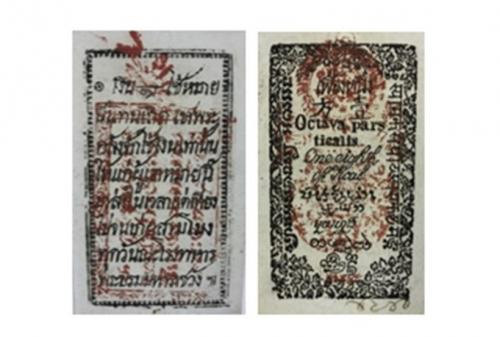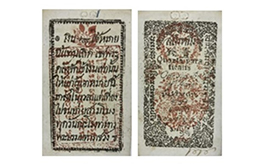Janejira Siharaj*
Pod Duang money and bia shells had been the main mediums of exchange since Sukhothai, Ayutthaya, Thonburi, until early Rattanakosin period. Pod Duang was of a higher denomination; whereas bia was the lower one. Such simple currency system was suitable for the society and the economic system at the time. However, in early Rattanakosin period, Thai economic system started to become increasingly complex, and the influence from the West started to play a significant role in changing Thai currency system. One of results was the creation of Mai, the first paper currency in the history of Thai currency which eventually became bank notes that are currently in use in the present day.
Backstory and the reason behind the attempt to replace old currency with Mai
Backstory and the reason behind the attempt to replace old currency with Mai
During his reign, King Rama IV implemented reforms, changes, and laid foundations to modernisation and civilisation for the country of Siam in many respects. Monetary reform is one of such great efforts. Due to changes in Thai economy, free markets were introduced; production for domestic use became manufacturing for sale, foreign merchants became more involved in domestic exchange. This new market environment called for more convenient and compatible circulation system. Plus, there was a high demand for money in circulation. As a result, Thai monetary system as well as its measurement underwent serious changes which included the introduction of Mai, the first kind of paper money used among other media of exchange. Important factors which contributed to the adoption of Mai in Thai economic system are:
1. The discontinuation of bia (shell money)
During the reign of King Rama III, there was an inflation which resulted in drastic decrease of value in bia. Plus, minted flat and round coins were being introduced into circulation to replace bia. Eventually, bia became obsolete and finally went out of circulation.
2. The issue of counterfeit Pod Duang
In the early reign of King Rama IV, counterfeit Pod Duang was prevalent. The king issued a decree to ban counterfeiting in 1855 AD, and commissioned smaller denominations of Pod Duang and sealed them with the symbol of a royal gourde in order to tackle the problem of both counterfeit Pod Duang and the devaluation of bia. These small denominations included salueng, fueang, half-fueang, phai, and half-phai. As for higher denominations, the King commissioned that Aksorn Pimpakarn, the royal printing house print paper notes to be introduced into circulation; these notes were called Mai.
3. Bowring Treaty
A greater amount of foreign coins entered Thai monetary system as an effect of the Bowring treaty. Foreign merchants had to bring these coins to the national treasury so that they could be melted into Pod Duang; however this was not enough to satisfy the demand. Therefore, King Rama IV commissioned more production of Pod Duang, as well as allowing the people to accept and use foreign coins as legal tenders. The first decree was announced in 1856, but was met with a cold reception. Therefore, another decree was announced in 1857. This time the king allowed his royal emblem to be branded on foreign coins in order to convince the people of the legitimacy of foreign coins.
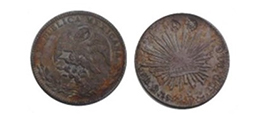
Mexican coins
Mai: The First Paper Money in Thai Currency System
As discussed, in the early period of King IV’s reign, legal tenders which were in use in the country were Pod Duang and bia. As the country’s economy was changing, namely from producing for domestic use to that of a commercial nature, the role of Pod Duang and bia started to become less important. Other contributing factors are the counterfeiting of Pod Duang and the issue of currency exchange with foreign merchants. To tackle these issues, King Rama IV commissioned a medium of exchange made of paper for the first time. It is called Mai. It was to be used alongside other forms of legal tenders, especially in the case of big payments of debt. Mai entered into circulation in 1853.
Features and Denominations
Mai was made of fine printing paper. The patterns on both sides of the paper were printed with ink. Every denomination was stamped with the great seal of the realm (the royal chakra seal) as well as the king’s privy seal (the crown seal) in cinnabar rouge in order to prevent counterfeiting. There are three types of Mai, namely Mai of low denominations, Mai of middle denominations, and Mai of high denominations.
1. Mai of low denominations: Six denominations were issued: 1 fueang, 1 saleung, salaeung fueang, 2 saleung, 3 salueng, and 1 baht.
Front
According to the king’s announcement introducing Mai as money in 1215 Minor Era or 1853 Common Era, on the note of low denomination Mai there is a botanical and floral print as a framing the note. The value of the note was written in 12 languages, for example, Thai, Chinese, Latin, English, Hindu, Malay, Mon, and Laos from top to bottom, in Bihar and Sanskrit from left to right, respectively.
Back
On the note there was a text printed in a rectangular text box; it reads: "This Mai is to be used in the place of money. The treasury will give money to the person who submits this note at the soldier’s hall in the Grand Palace every day from noon to three o’clock in the afternoon.” A traditional symbol (the royal lotus seal) was stamped to mark the value of the note; the numbers of stamps vary from one to eight stamps depending on the value of each note. The note was also stamped with another royal seal in the name of the capital written in Khmer; it reads: ‘Krung Thewamahanakorn Amornrattanakosin Mahinthara Yuthachiya Borommaratchathani’.
Another distinct feature of low-denomination Mai is that there is an embossed design of fueang money on the top of the note. The number of fueang images can vary, depending on the value of that note, for example a Mai note of one-fueang would have one embossed fueang image, a Mai note of one salueng would have two embossed fueang images, a Mai note of one baht would have eight embossed images. The embossment was for the purpose that the people who were not able to read, visually impaired, or old people could tell the value and genuinity of the note by feeling it. This is also a measure to prevent counterfeiting.
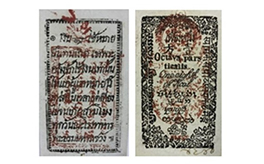
One fueang Mai
front (left) and back (right)
Printed in portrait, 5 cm in width and 8.7 cm in length
One saleung Mai
front (left) and back (right)
Printed in portrait, 5 cm in width and 8.7 cm in length
2. Mai of middle denomination
There are four denominations: three tamlueng, four tamlueng, six tamlueng, and ten tamlueng.
Front
There were two patterns that framed this type of Mai: the outer frame is a botanical pattern in western style, while the inner is a rectangular frame of vine pattern. There is a text inside indicating in Thai the value of the note and the guarantee thereof by the government. It reads "Four tamlueang will be given in exchange of this Mai note. Holding this note ensures no loss of wealth.” On the middle top part of the note at both sides of the text are stamps of Chinese letter, fu (meaning to guard or to protect), in red. The number of the stamps equals the value of the note in tamlueng. To prevent counterfeiting, an image of a leaf was stamped over the fu letter(s).
Back
The back of the note is covered with a pattern of botany, flowers, and vines. In the middle, there is a stamp of a royal seal in the name of the capital which was written in Khmer; it reads: ‘Krung Thewamahanakorn Amornrattanakosin Mahinthara Yuthachiya Borommaratchathani’. Additionally, some Mai notes were found to have a print of King Rama IV’s handwritings in English, which reads "Dix Money 16 ticals S.P.P.M. Mongkut’s 3rd Year”; 3rd year meaning the third year after the king’s coronation. This indicates that this Mai note of middle denomination was produced in 1853.
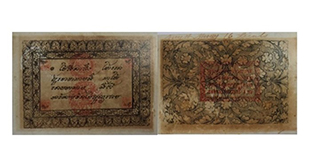
Four tamlueng Mai
front (left) and back (right)
Printed in landscape, 10 cm in width and 14 cm in length
3. Mai of high denomination
There are two denominations of this type: 20 bath and 80 baht.
Front
The outer frame of the note is of several print patterns. On the brim is a text in Thai indicating the value of the note, i.e. 20 and 80 baht. Inside, there is a rectangular text box which says, ‘This Mai is exchangeable for 320 siek, or 640 siao, or 1280 At, 2560 solot. It is valued at 20 baht, or 5 tamleung, or 12 mexican coins, or 28 rupiah, exchangeable at the royal treasury, trustworthy. No:…’ Since this type of Mai was of high value, the indication of lot number and lot letter was also printed on the notes.
Back
At the outer brim of the note, there was a text box indicating the value of the note in English (twenty ticals or eighty ticals).
Twenty tamlueng Mai
front (left) and back (right)
Printed in portrait, 6.2 cm in width and 8.7 cm in length
The use of Mai in Thai Economy
1. The issuance of Mai
Mai was first issued in 1853 CE. The primary evidence is a record of the king’s order in the national annals of King Rama IV’s reign in 1215 Minor Era or 1853 CE where Mai was announced as exchangeable legal tender in order to inform the people, and to ensure that there was no counterfeiting of Mai. The king would reward those who could report a counterfeited Mai, and those who exchanged Mai for other kind of money; for every ten Mai notes, the king would award another Mai note as a prize.
2. The use of Mai
Mai was used as a medium of exchange in trade and to pay debt. King Rama IV commissioned several denominations for convenience use in trade. Those who had Mai notes in possession was able to exchange them for money at the military hall in the Royal Palace as indicated in the annals of the reign of King Rama IV written in 1215 Minor Era. Additionally, in the announcement regarding the value of the currency baht and pae issued in 1860, there was also a mention of Mai: "as for baht coins, half-baht coin, pae salueng, pae fueang, should they were not of any one’s liking, they can be readily exchanged for baht, half baht, salueng, feuang as shown in the picture. They all are exchangeable for money; just as Mai is.”
3. It is assumed that Mai of low denominations were intended to be circulated both among foreign merchants and Thai people because there the value of the note was indicated in 12 different languages.
4. It is assumed that Mai of middle denominations were intended for Chinese merchants because they were issued as tamleung which was an ancient Chinese Currency.
5. It is assumed that Mai of high denominations were intended for Western merchants because the indication of the value of the notes were written in English, namely ticals, or baht.
6. The discontinuation of Mai
It is not clear when Mai went out of circulation. The last announcement that mentioned mai was the announcement regarding the awarding of allowance in the form of gold coins of different denominations, e.g. thongthod, thongpid, thongpaddueng, in 1864. One part of the announcement reads "It is a royal order that thongthod, thongpid, thongpaddueng to be made and used as currency like Mai. They are exchangeable for 8 baht, 4 baht, and 10 saleung, respectively.”
7. Mai was the first paper currency in Thai currency system. The use of mai is considered an important stepping stone for the use of paper currency in a later period. There is another type of paper currency issued by the order of King Rama IV called ‘the royal award of currency’, but it was as unpopular as Mai. Therefore, the two types of paper money gradually went out of circulation in King Rama’s IV reign.
The discontinuation of Mai
Mai was unpopular and was not generally accepted, eventually resulting in its discontinuation. Possible reasons are:
1. Mai was a completely new currency. The people were more familiar with Pod Duang which had been in use since ancient times. Moreover, unlike Pod Duang which is made of silvers, Mai is made of paper which was seen as less valuable and unworthy.
2. The value of Mai of all denominations was clearly printed. However, very few Thai people could read; therefore people might not understand the value of the currency or were confused, resulting in a cold reception.
3. Paper currency might not be convenient to carry. In the past, people carried Pod Duang money used ‘thai’, a small pouch attached to one’s waist. In order to carry Mai in thai, it had to be folded or rolled. If kept outside, it also had to be folded or rolled and stuck around the person’s waist, and can easily be damaged due to sweat. Furthermore, printing technology at the time were still not advanced, the print of Mai might have become blurry very easily. Such imperfect condition would affect the trustworthiness of the currency, resulting in it not being accepted.
4. The use of Mai was very limited. Even in markets in Bangkok, bia was still the currency of choice. Sir John Bowring wrote in The Kingdom and People of Siam, "markets are full of vegetables and fruit; there are beef, pork, and fish. I did not see other currency apart from bia.”
Mai was the first paper currency in Thai currency system. Its creation was due to a Western influence, and also reflects the prowess of King Rama IV in reforming Thai monetary system. The king began by solving problems in the currency system, and then mapped out a new system leading to the production of banknotes which materialized in the reign of King Rama V, and was the system that persisted until today.
* Curator, Practitioner Level, Bureau of Grand National Treasury under the Treasury Department
